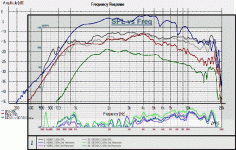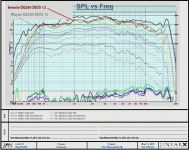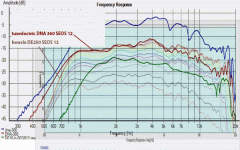I do not want to see this turn into another argument, so I'll not reply to the last few posts.
I will, however, post response charts made by various people. I will leave it to the readers to interpret the results.
Here is the most commonly published SEOS12 chart, which I think was made by Bill Waslo:

A chart made by Erich:
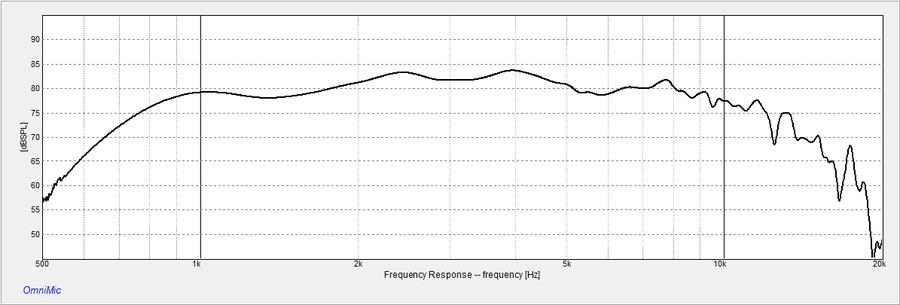
Another chart made by Bill Waslo:

This is the chart I made of an SEOS12 waveguide, mounted on a baffle, measured outdoors:
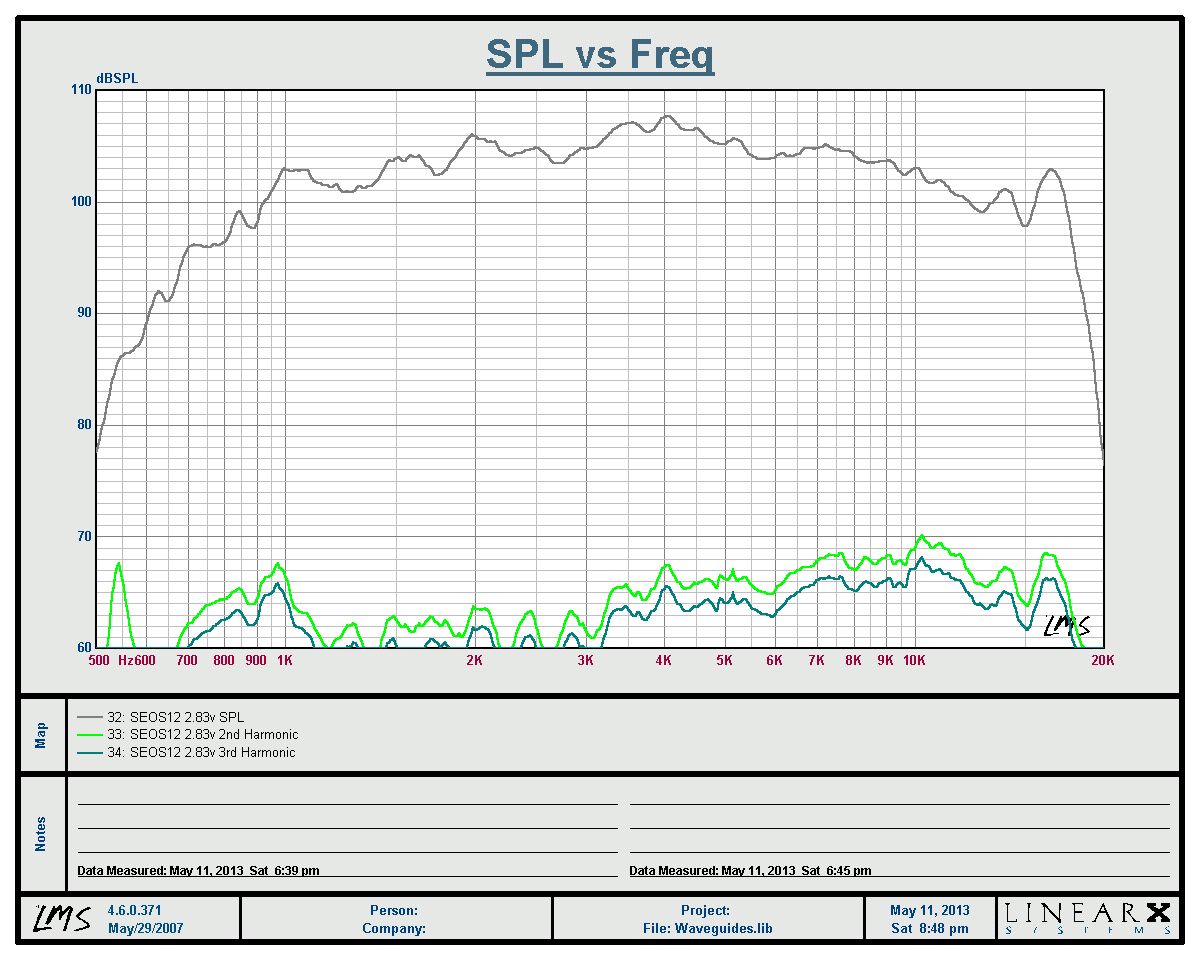
These all appear to reasonably agree. Of course, they were taken in different environments, under different conditions with different measurement systems and perhaps some using different compression drivers. But the general trend is evident.
I think tuxedocivic objected to one of Bill's charts above, and also to the one below. Seems like he said the chart was inaccurate.
It is definitely scaled differently than most others.
(from this post: SEOS-12 / DNA-360 / JBL 2226(J) build)
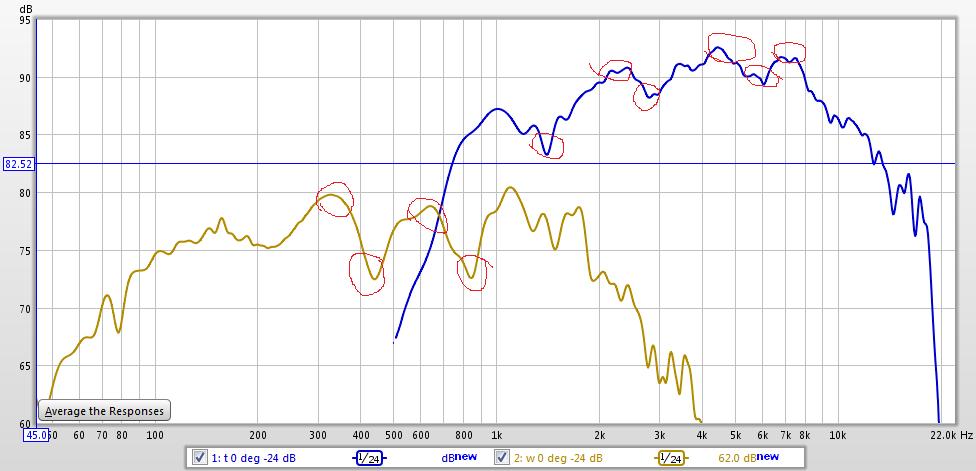
The same person made this chart, and posted it later in the same thread.
(from this post: SEOS-12 / DNA-360 / JBL 2226(J) build)
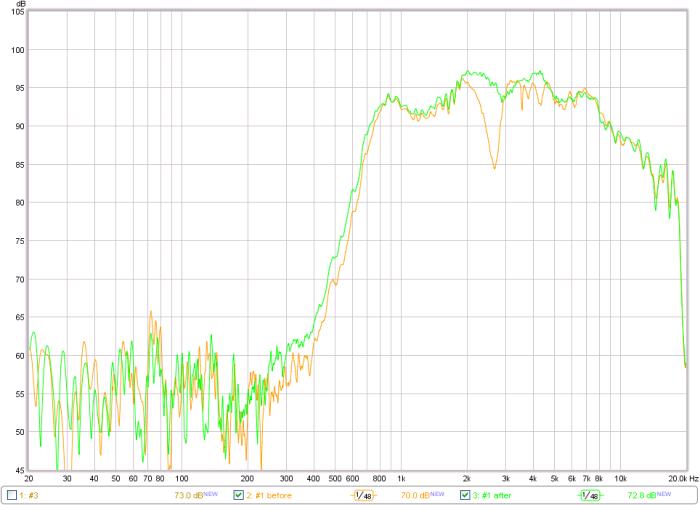
In this second chart, I can see the deep notch around 2.7kHz, which really IS anomalous for the SEOS12 device. But the green curve has the same basic signature as the blue curve in the link above. The green "fixed" curve looks quite similar to the blue curve above that tuxedocivic marked up with his red circles. To be quite honest, except for the scaling difference, it appears to be basically the same curve as all the others we've been discussing here.
Here's the SEOS12 overlayed with the H290C, same compression driver, same 1M baffle, same measurement system, drive signal and 1M microphone distance. Measured outdoors.
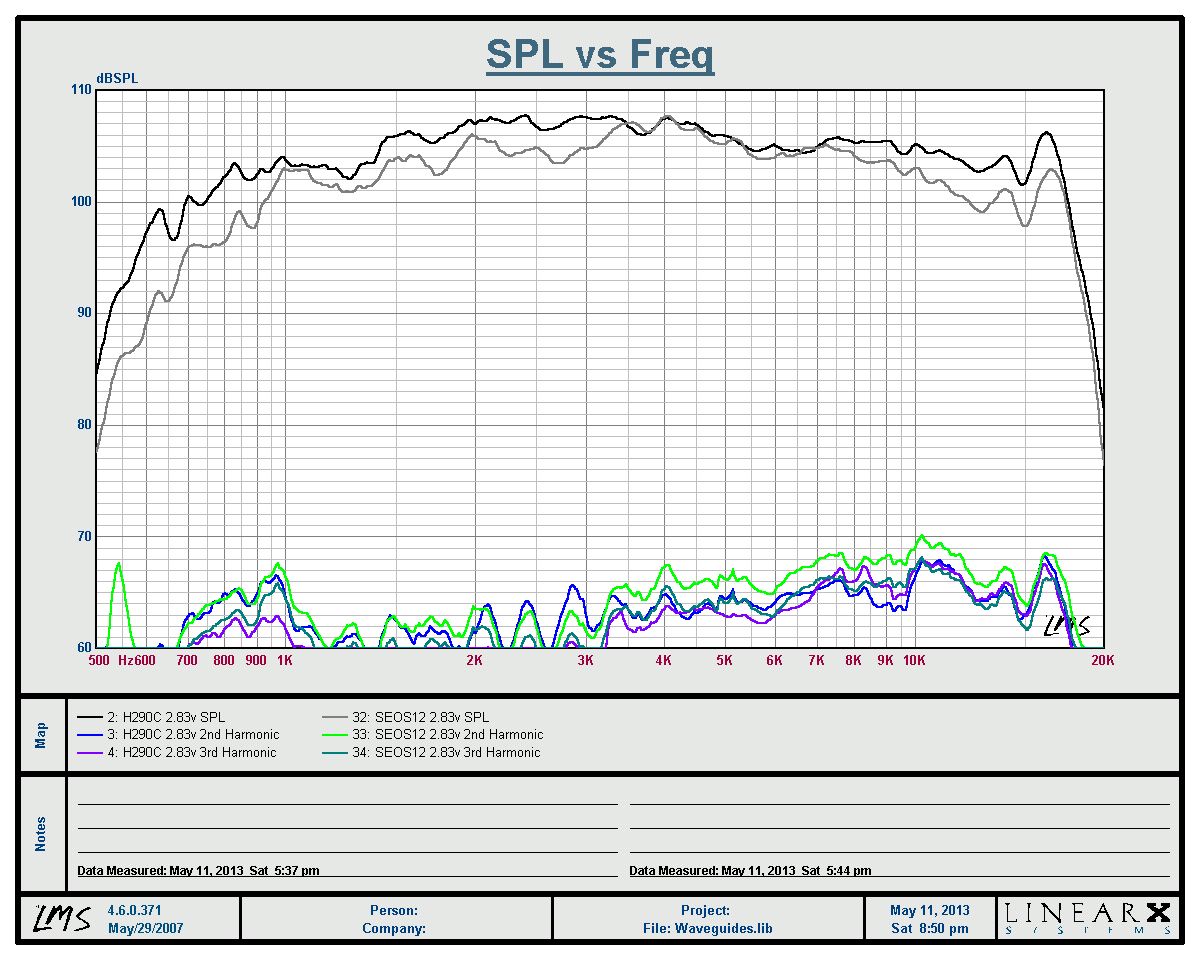
Matt Grant also measured the two waveguides, although I think he used a different compression driver and I don't think he mounted them on a baffle. I also think he measured indoors. Still, his charts are pretty similar to my measurements:
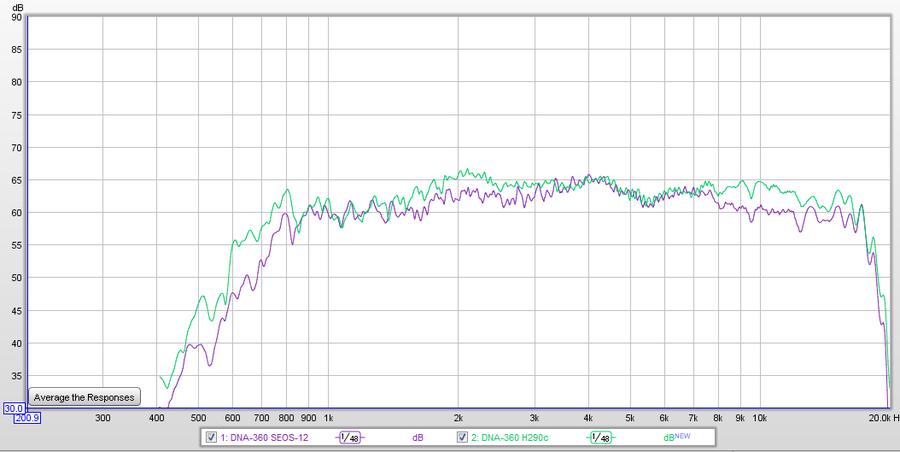
I dunno guys. Except for scaling differences, these all seem to be in reasonable agreement to me. I think the trend is clear and we can be reasonably confident that we are seeing valid data for both the H290C and SEOS12 waveguides.
I will, however, post response charts made by various people. I will leave it to the readers to interpret the results.
Here is the most commonly published SEOS12 chart, which I think was made by Bill Waslo:

A chart made by Erich:

Another chart made by Bill Waslo:

This is the chart I made of an SEOS12 waveguide, mounted on a baffle, measured outdoors:

These all appear to reasonably agree. Of course, they were taken in different environments, under different conditions with different measurement systems and perhaps some using different compression drivers. But the general trend is evident.
I think tuxedocivic objected to one of Bill's charts above, and also to the one below. Seems like he said the chart was inaccurate.
It is definitely scaled differently than most others.
(from this post: SEOS-12 / DNA-360 / JBL 2226(J) build)

The same person made this chart, and posted it later in the same thread.
(from this post: SEOS-12 / DNA-360 / JBL 2226(J) build)

In this second chart, I can see the deep notch around 2.7kHz, which really IS anomalous for the SEOS12 device. But the green curve has the same basic signature as the blue curve in the link above. The green "fixed" curve looks quite similar to the blue curve above that tuxedocivic marked up with his red circles. To be quite honest, except for the scaling difference, it appears to be basically the same curve as all the others we've been discussing here.
Here's the SEOS12 overlayed with the H290C, same compression driver, same 1M baffle, same measurement system, drive signal and 1M microphone distance. Measured outdoors.

Matt Grant also measured the two waveguides, although I think he used a different compression driver and I don't think he mounted them on a baffle. I also think he measured indoors. Still, his charts are pretty similar to my measurements:

I dunno guys. Except for scaling differences, these all seem to be in reasonable agreement to me. I think the trend is clear and we can be reasonably confident that we are seeing valid data for both the H290C and SEOS12 waveguides.
More bogus charts. But this isn't bashing the community driven waveguide? The chart you said I posted is not correct. But nice try. And half the other ones are from the guy that said he was measuring wrong. Remember.....we all went over that before you had your posts deleted and 'some people' were banned.
Wayne, I'm not trying to argue at all. Or is this just a one sided debate??? Actually, I'm assuming all of these threads that you've posted on every audio website forum in the past couple days was not intended to bash any one waveguide model right....."only to help"....right? You wouldn't be bashing....only helping. Even though you only target one model. Why are you so obsessed with the new SEOS? What about the JBL or QSC? Please explain.
If it's not intended to bash one waveguide model so you can make your money, then you should have no problem helping the DIY community design this perfect 'uniform' waveguide right?
I believe the OS has it's place, I believe the EOS has it's place. Obviously the SEOS does too. So I see no reason why we shouldn't also make up something you claim will be better.
I'm willing to help out and get them produced so we can keep the price low. You could help with the design. Like I said, the CNC company in Kentucky will cut us front speaker baffles for around $15, and I'll work on the flat packs. And you've already explained why it might be better in this thread.....so we'd have the best of both worlds to pick from.
Let me know if I can help out or not.
Wayne, I'm not trying to argue at all. Or is this just a one sided debate??? Actually, I'm assuming all of these threads that you've posted on every audio website forum in the past couple days was not intended to bash any one waveguide model right....."only to help"....right? You wouldn't be bashing....only helping. Even though you only target one model. Why are you so obsessed with the new SEOS? What about the JBL or QSC? Please explain.
If it's not intended to bash one waveguide model so you can make your money, then you should have no problem helping the DIY community design this perfect 'uniform' waveguide right?
I believe the OS has it's place, I believe the EOS has it's place. Obviously the SEOS does too. So I see no reason why we shouldn't also make up something you claim will be better.
I'm willing to help out and get them produced so we can keep the price low. You could help with the design. Like I said, the CNC company in Kentucky will cut us front speaker baffles for around $15, and I'll work on the flat packs. And you've already explained why it might be better in this thread.....so we'd have the best of both worlds to pick from.
Let me know if I can help out or not.
Last edited:
Yeah you've proven you can still ignore me and then post bogus FR charts and leave out the ones that are actually done well and show a good FR. At least this time you linked to the thread where I explain to brad there's a problem. For others' reference, that's a JBL 2226 woofer measured along side the SEOS with the same saw teeth pattern. I was not the only one who knew there was a problem. Coctostan took one look and didnt even want to attempt a cross over.
If I can paraphrase what you said 'I won't acknowledge the previous posts, instead ill just post some cherry picked measurements to try and push my agenda.'
If I can paraphrase what you said 'I won't acknowledge the previous posts, instead ill just post some cherry picked measurements to try and push my agenda.'
Hi there Mr. Scaper,
I'm not sure if you realize this but you're coming on a bit strong.
It is interfering with your message.
Most readers have been around the diy-audio-website block and put quotes around, and take salt with, most advice. We also unfortunately realize that there is at least one flame war behind all technical discussions--I can hear the anger in your posts.
But I can also see some olive branches! Perhaps this is an opportunity to leave the war behind--even if there still seems to be some enemy troop movements.
If there is some technical info you feel is missing, could you point us to it? I am merely a communicator but others here have the technical knowledge, skills and experience to critically evaluate the topics discussed--these readers aren't easily fooled.
Everyone understands your concerns. I would love to hear more about the technical merits of the two approaches and the pros and cons as seen by all parties.
Cheers,
Jeff
I'm not sure if you realize this but you're coming on a bit strong.
It is interfering with your message.
Most readers have been around the diy-audio-website block and put quotes around, and take salt with, most advice. We also unfortunately realize that there is at least one flame war behind all technical discussions--I can hear the anger in your posts.
But I can also see some olive branches! Perhaps this is an opportunity to leave the war behind--even if there still seems to be some enemy troop movements.
If there is some technical info you feel is missing, could you point us to it? I am merely a communicator but others here have the technical knowledge, skills and experience to critically evaluate the topics discussed--these readers aren't easily fooled.
Everyone understands your concerns. I would love to hear more about the technical merits of the two approaches and the pros and cons as seen by all parties.
Cheers,
Jeff
Here's another for your comparison
spaced for clarity. Red is the DNA-360 which is apparently very similar to the DE250. Green is the DNA-205 which is apparently very similar to the DE10. Blue is the DNA-350 which is big powerful tough and not as fine and I don't know what it's based off of. I managed to get it into shape, but those little 5.5 and 8.5khz didn't go away. Not audible, but if going for hifi, the 360 obviously performs better.
Looking at the red curve you can see the low end knee is beautiful. Combined with directivity down to 1200hz or even lower, this is one heck of a waveguide. The peak at 4khz gets knocked out quite easily with a single notch and stays consistent off axis, so go right ahead and eq it out.
An externally hosted image should be here but it was not working when we last tested it.
spaced for clarity. Red is the DNA-360 which is apparently very similar to the DE250. Green is the DNA-205 which is apparently very similar to the DE10. Blue is the DNA-350 which is big powerful tough and not as fine and I don't know what it's based off of. I managed to get it into shape, but those little 5.5 and 8.5khz didn't go away. Not audible, but if going for hifi, the 360 obviously performs better.
Looking at the red curve you can see the low end knee is beautiful. Combined with directivity down to 1200hz or even lower, this is one heck of a waveguide. The peak at 4khz gets knocked out quite easily with a single notch and stays consistent off axis, so go right ahead and eq it out.
I can't believe you guys still have more bickering in you after all that crap on AVS. It's boring and embarrassing. They are close enough that figuring out which one gives better alignment of acoustic centers with a given woofer is probably a more pressing concern than anything else.
As for the charts, can somebody show me a measurement of the SEOS 12 where it looks better than this one below, aside from smoothing and scaling? I don't recall seeing one (nor do I see any big issues with this response).

As for the charts, can somebody show me a measurement of the SEOS 12 where it looks better than this one below, aside from smoothing and scaling? I don't recall seeing one (nor do I see any big issues with this response).

Here is that (red line) scaled and overlayed to Wayne's SEOS12 + DE250 measurement (grey line). The "low end knee" is not the discrepancy that needs explanation here, I'm thinking.Here's another for your comparison
...
Red is the DNA-360 which is apparently very similar to the DE250.
Attachments
Hey dump truck. Thanks for overlaying. The high frequency roll of I got there is quite likely the little Dayton t amp I've been using lately. I've heard it has a soft top end. And I've noticed a few of my measurements have a bit of top end roll off lately. I haven't had a chance to look at it closely, but that is more pronounced than I've noticed, so who knows.
Sorry if I come across as bickering. It's the Brad Measurement that I've asked Wayne to stop using over and over because its wrong. I wanted to show that measurement to be false. Brad had a suspect CD and was inexperienced. The results were not reliable. I feel responsible for these measurements cause I was helping Brad at the time. Wayne is aware they shouldn't be used but I keep getting it thrown in my face. So, there's my measurement for him to use. I just did it quick tonight, when I find more time to put it on my measurement amp, I can share it with him if he cares.
Thanks again for the comparison.
Sorry if I come across as bickering. It's the Brad Measurement that I've asked Wayne to stop using over and over because its wrong. I wanted to show that measurement to be false. Brad had a suspect CD and was inexperienced. The results were not reliable. I feel responsible for these measurements cause I was helping Brad at the time. Wayne is aware they shouldn't be used but I keep getting it thrown in my face. So, there's my measurement for him to use. I just did it quick tonight, when I find more time to put it on my measurement amp, I can share it with him if he cares.
Thanks again for the comparison.
I don't want to bicker. I'd like to see us refrain from namecalling here. So tuxedocivic, if you want to throw out Brad's measurements - Fine. There are plenty of others that all show the same characteristic response.
But I've been doing this for a while, and in my opinion, Brad's measurement was not anomalous. It was showing you the accurate response. It was just scaled in a way that made the ripples seem larger. It's really the same amplitude as other charts, just scaled differently.
There was a different chart that showed a deep notch that Brad corrected - the one plotted in yellow. That much I can see in the yellow line in one of Brad's charts. And the 2226J response was modified by internal standing waves in the cabinet, or at least we can infer that from the fact that Brad said the addition of damping material reduced the peaks in the woofer range:
But as for the waveguide charts shown above, they all appear to match pretty well, seems to me. The insulation in the cabinet wouldn't affect waveguide response.
That is my opinion.
I think the data is pretty clear. As Evan used to say, "More Data, Less Wank".
But I've been doing this for a while, and in my opinion, Brad's measurement was not anomalous. It was showing you the accurate response. It was just scaled in a way that made the ripples seem larger. It's really the same amplitude as other charts, just scaled differently.
There was a different chart that showed a deep notch that Brad corrected - the one plotted in yellow. That much I can see in the yellow line in one of Brad's charts. And the 2226J response was modified by internal standing waves in the cabinet, or at least we can infer that from the fact that Brad said the addition of damping material reduced the peaks in the woofer range:
But as for the waveguide charts shown above, they all appear to match pretty well, seems to me. The insulation in the cabinet wouldn't affect waveguide response.
That is my opinion.
I think the data is pretty clear. As Evan used to say, "More Data, Less Wank".
Last edited:
Tuxedocivic, I wrote you a PM. Hopefully this will be an olive branch between us, at least start some understanding.
However, I do not see any reason to complain that Brad's measurements were anomalous. As I said in my last post, and many times before, it is my opinion Brad's measurements showed you accurate data. It was just scaled in a way that made it appear wrong to you.
Here is a crude overlay, stretched to approximate the same scale as the SEOS measurement I made:
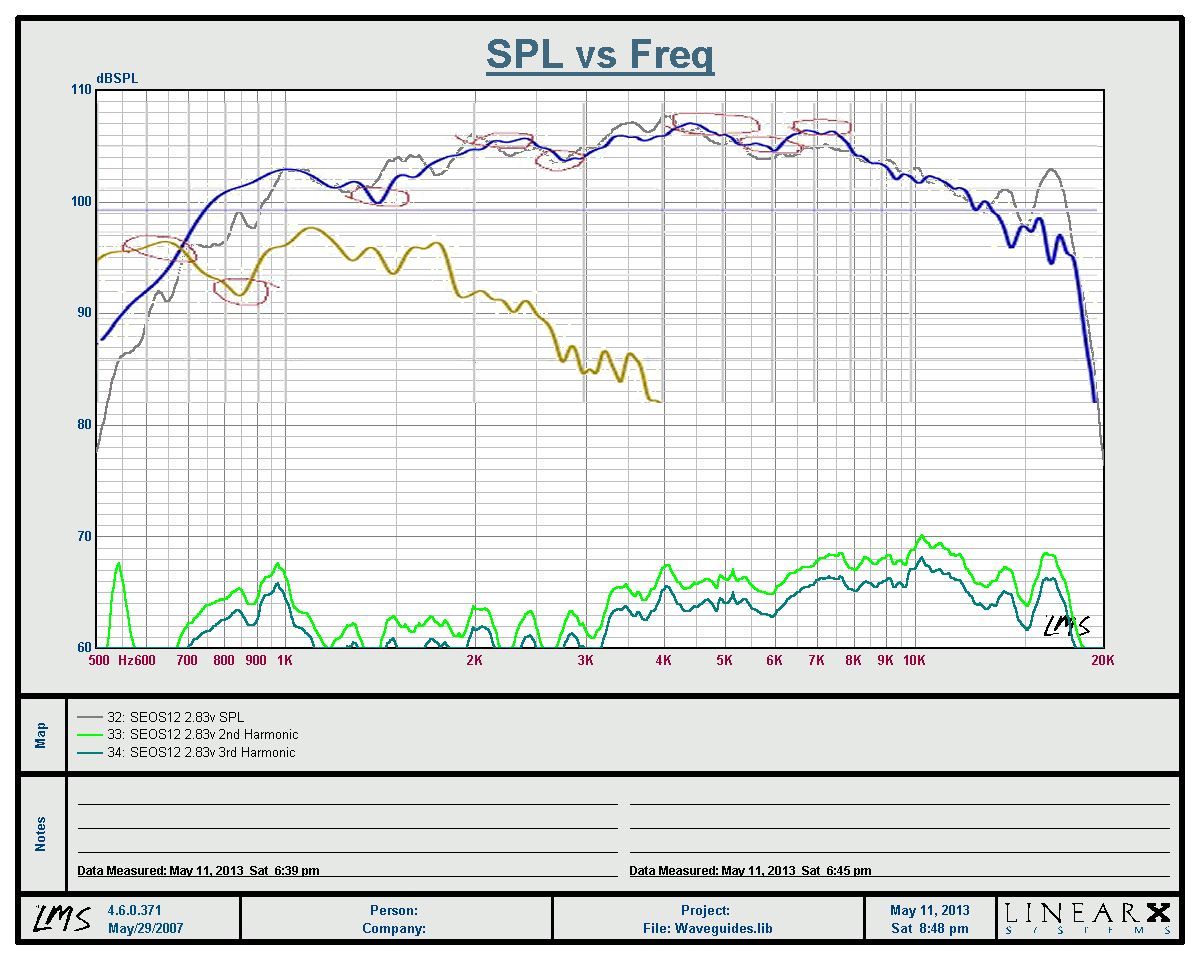
However, I do not see any reason to complain that Brad's measurements were anomalous. As I said in my last post, and many times before, it is my opinion Brad's measurements showed you accurate data. It was just scaled in a way that made it appear wrong to you.
Here is a crude overlay, stretched to approximate the same scale as the SEOS measurement I made:

Last edited:
As Evan used to say, "More Data, Less Wank".
The yellow and the blue line graph show evident peaks and ridges
What the graph tells is that those ridges would represent real resonances when
playing.
It's what geddes had investigated in. HOLM is the final thesis.
Talking about the topic, I haven't read it 
But we should first define what is a speaker and what's its usage, or purpose.
The first graphs about dispersion are a better rendering, but still are no representative of how a speaker sounds - as every measuration, if it is not precisely referred....
But we should first define what is a speaker and what's its usage, or purpose.
The first graphs about dispersion are a better rendering, but still are no representative of how a speaker sounds - as every measuration, if it is not precisely referred....
Wayne, you seem overly obsessed with the SEOS and doing whatever you can to find flaws, even if it means using charts you know are incorrect. People can look all the want, but I have never made one bad comment about your stuff. Not one. So why have you been bashing it over all the other models that are out there like the JBL or QSC? Can you please explain? Most guys on here don't know about what you've done on other sites.
If this thread you started is all about helping and teaching, then will you help the DIY community design this perfect 'uniform' waveguide?
I'm willing to help out and get them produced so we can keep the price low. You could help with the design. Like I said, the CNC company in Kentucky will cut us front speaker baffles for around $15, and I'll work on the flat packs. And you've already explained why it might be better in this thread.....so we'd have the best of both worlds to pick from. I believe the OS has it's place, I believe the EOS has it's place. Obviously the SEOS does too. So let's make up something you claim will be better.
Let me know if I can help all of us out or not. If you think we need another horn design, I'll do my best to get it done like we did with the SEOS. And because you've already explained all the merits for why we need this other shape, we can just direct people to your threads for the explanation. The DIY community would then be able to choose between the EOS, SEOS, and then whatever you helped with.
Please let me know if you want to proceed.
Also, for future references, can you please explain to us when a uniform horn should be used instead of an EOS, or SEOS?
If this thread you started is all about helping and teaching, then will you help the DIY community design this perfect 'uniform' waveguide?
I'm willing to help out and get them produced so we can keep the price low. You could help with the design. Like I said, the CNC company in Kentucky will cut us front speaker baffles for around $15, and I'll work on the flat packs. And you've already explained why it might be better in this thread.....so we'd have the best of both worlds to pick from. I believe the OS has it's place, I believe the EOS has it's place. Obviously the SEOS does too. So let's make up something you claim will be better.
Let me know if I can help all of us out or not. If you think we need another horn design, I'll do my best to get it done like we did with the SEOS. And because you've already explained all the merits for why we need this other shape, we can just direct people to your threads for the explanation. The DIY community would then be able to choose between the EOS, SEOS, and then whatever you helped with.
Please let me know if you want to proceed.
Also, for future references, can you please explain to us when a uniform horn should be used instead of an EOS, or SEOS?
I ask you to not use that measurement. You agree to not while justifying it. I say thank you for not. Then you continue to use it.
I'm aware of scale. I'm aware of standing waves in boxes. In your pm you said it may have been the nearfield technique. Brad didnt use nearfield.
I don't care if its close to your measurement. I still believe it is not reliable. Stop using it please.
Hi
To whatever degree this thread isn’t about personal choice, there really is more of value than the oddly frequent use of the word directivity without actually looking at the ramifications of directivity.
While that topic may be relatively new in the hifi area, “where the sound goes” is old news and well understood outside that environment.
While not subjective like music appreciation, If one wants to preserve or transfer information like words or a stereo image then directivity is very important at least within a room.
What does one actually hear in a room? Well you hear a combination of direct and reflected sound and in large scale sound to understand words, one wants the direct sound to be ideally at least +10dB louder than the reflected sound. As the Princeton U 3D stereo lab showed, directivity was the single largest factor in having their interaural crosstalk to work as well (which also depends on transmission of intact information to your ears).
If one is mostly interested in nice looking graphs, probably an accuton dome on a flat baffle would give the nicest looking vs angle I have seen. Some of them are incredibly well behaved sources.
On the other hand, from a “what should the speaker do” point of view, go stand where your R or L speaker is with a protractor.
From your loudspeakers location, how wide and how high in degrees is the primary listening area (like your couch say)? This would be where you want to concentrate the sound because there are no reflections before the sound reaches your ears.
The sound energy going in all the other directions plus the direct sound energy are what makes up the reverberant field in your room and as Floyd Toole’s work showed, generally, people prefer the reverberant field spectrum to be similar / the same as the direct fields spectrum.
This requires constant directivity (same angular dispersion vs frequency) and so a tiny dome or other source with little or no directivity is the easiest way to arrive at constant directivity (but of very little or no directivity).
In this case, the spectral balance anywhere you are in the room will sound very similar to sitting in the sweet spot where you hear (what’s left of) a stereo image. You can enjoy this system anywhere in your room.
You can improve on this by having your listening position in the loudspeakers near field or up close to them, this way the direct sound is automatically louder by virtue of the inverse square law and the reflections set back in time and level because you are close to the source while the first reflections farther away..
You can improve on this also by using directivity, simply reducing how much energy is radiated in the wrong or harmful directions that directly drive the reverberant field and reflections. Now the near field became larger (being the region where the direct sound is significantly louder than the reflected sounds). But also now, the reverberant field’s spectrum is the direct sound plus the reflected sound so as before it is desirable to have constant directivity which is needed to have a similar direct and reverberant spectrums.
An example of not having this, many have probably heard large curved wall horns in rooms and while they can sound great in the sweet spot, elsewhere in the room, they can sound very murky and dark, not very listenable there because of the changing directivity.
The reverberant spectrum in the room is the interaction of the loudspeakers total Power response and so horns which narrow with increasing frequency radiate less and less energy with increasing frequency even though on axis they are flat.
The point of all this is, if you guys are really interested in directivity as it effects what you hear, you need to look at the desired listening angle AND how much energy goes elsewhere vs frequency.
In commercial sound, it in pretty common to compare what is happening 90 degrees off axis and to the rear. I haven’t seen that hifi speakers are measure over the entire sphere but often they measure the front half at least in X and Y..
If one loudspeaker measured -3dB @ 90 degrees off axis and another one was -20dB @ 90 degrees off axis, what does that tell you?
In the first case (-3dB) the energy going 90 degrees off axis is only half the level going forward and so will be strongly driving the room.
The one that was -20dB is only radiating about 1/100 the energy @ 90 degrees off axis and so whatever that response looks like, it only contributes a TINY bit to the reverberant spectrum and so the reverberant spectrum is nearly the same as the on axis spectrum.
If one could make a source that confined ALL the energy into the desired angular coverage, the reverberant and direct spectrum would be identical, this is the “grail” for dealing with room acoustics, Constant directivity WITH a high degree of directivity.
The larger the room, the less absorption there is compared to stored energy and so directivity becomes critical.
So one might ask between the conceptually perfect cases and what governs the results, where does one want to compromise? Obviously even with modest directivity like these horns have an audible and positive effect for some listeners.
For hifi where this stuff is somewhat new and nothing like universally considered, just not having the “Christmas tree” looking map is doing pretty good (having the upper and lower sources have similar directivity at xover) and at least in that domain they appear to be more like one source.
It is perhaps time for hifi to adopt / show / measure 3D polar balloons which show how much energy gores in every direction as well.
How much energy goes to the listener(s) angular position, how much energy is radiated elsewhere, how do those horns stack up or compare from the real / acoustical directivity perspective?
Best,
Tom Danley
To whatever degree this thread isn’t about personal choice, there really is more of value than the oddly frequent use of the word directivity without actually looking at the ramifications of directivity.
While that topic may be relatively new in the hifi area, “where the sound goes” is old news and well understood outside that environment.
While not subjective like music appreciation, If one wants to preserve or transfer information like words or a stereo image then directivity is very important at least within a room.
What does one actually hear in a room? Well you hear a combination of direct and reflected sound and in large scale sound to understand words, one wants the direct sound to be ideally at least +10dB louder than the reflected sound. As the Princeton U 3D stereo lab showed, directivity was the single largest factor in having their interaural crosstalk to work as well (which also depends on transmission of intact information to your ears).
If one is mostly interested in nice looking graphs, probably an accuton dome on a flat baffle would give the nicest looking vs angle I have seen. Some of them are incredibly well behaved sources.
On the other hand, from a “what should the speaker do” point of view, go stand where your R or L speaker is with a protractor.
From your loudspeakers location, how wide and how high in degrees is the primary listening area (like your couch say)? This would be where you want to concentrate the sound because there are no reflections before the sound reaches your ears.
The sound energy going in all the other directions plus the direct sound energy are what makes up the reverberant field in your room and as Floyd Toole’s work showed, generally, people prefer the reverberant field spectrum to be similar / the same as the direct fields spectrum.
This requires constant directivity (same angular dispersion vs frequency) and so a tiny dome or other source with little or no directivity is the easiest way to arrive at constant directivity (but of very little or no directivity).
In this case, the spectral balance anywhere you are in the room will sound very similar to sitting in the sweet spot where you hear (what’s left of) a stereo image. You can enjoy this system anywhere in your room.
You can improve on this by having your listening position in the loudspeakers near field or up close to them, this way the direct sound is automatically louder by virtue of the inverse square law and the reflections set back in time and level because you are close to the source while the first reflections farther away..
You can improve on this also by using directivity, simply reducing how much energy is radiated in the wrong or harmful directions that directly drive the reverberant field and reflections. Now the near field became larger (being the region where the direct sound is significantly louder than the reflected sounds). But also now, the reverberant field’s spectrum is the direct sound plus the reflected sound so as before it is desirable to have constant directivity which is needed to have a similar direct and reverberant spectrums.
An example of not having this, many have probably heard large curved wall horns in rooms and while they can sound great in the sweet spot, elsewhere in the room, they can sound very murky and dark, not very listenable there because of the changing directivity.
The reverberant spectrum in the room is the interaction of the loudspeakers total Power response and so horns which narrow with increasing frequency radiate less and less energy with increasing frequency even though on axis they are flat.
The point of all this is, if you guys are really interested in directivity as it effects what you hear, you need to look at the desired listening angle AND how much energy goes elsewhere vs frequency.
In commercial sound, it in pretty common to compare what is happening 90 degrees off axis and to the rear. I haven’t seen that hifi speakers are measure over the entire sphere but often they measure the front half at least in X and Y..
If one loudspeaker measured -3dB @ 90 degrees off axis and another one was -20dB @ 90 degrees off axis, what does that tell you?
In the first case (-3dB) the energy going 90 degrees off axis is only half the level going forward and so will be strongly driving the room.
The one that was -20dB is only radiating about 1/100 the energy @ 90 degrees off axis and so whatever that response looks like, it only contributes a TINY bit to the reverberant spectrum and so the reverberant spectrum is nearly the same as the on axis spectrum.
If one could make a source that confined ALL the energy into the desired angular coverage, the reverberant and direct spectrum would be identical, this is the “grail” for dealing with room acoustics, Constant directivity WITH a high degree of directivity.
The larger the room, the less absorption there is compared to stored energy and so directivity becomes critical.
So one might ask between the conceptually perfect cases and what governs the results, where does one want to compromise? Obviously even with modest directivity like these horns have an audible and positive effect for some listeners.
For hifi where this stuff is somewhat new and nothing like universally considered, just not having the “Christmas tree” looking map is doing pretty good (having the upper and lower sources have similar directivity at xover) and at least in that domain they appear to be more like one source.
It is perhaps time for hifi to adopt / show / measure 3D polar balloons which show how much energy gores in every direction as well.
How much energy goes to the listener(s) angular position, how much energy is radiated elsewhere, how do those horns stack up or compare from the real / acoustical directivity perspective?
Best,
Tom Danley
Illustrator and Photoshop. It only takes a moment to do it quick & dirty like this, but then I do work with this software all day for a living. Here's those two, and another two:How do you do that dump truck? I wonder how mine would compare to Bill's measurement. My eyeball comparison doesn't show such a high roll off. I was also using the DNA-360, I wonder if it has more roll off than the 250, but I wouldn't know.
Attachments
As the Princeton U 3D stereo lab showed, directivity was the single largest factor in having their interaural crosstalk to work as well
I don't know about "Princeton 3D" but according to Toole the interaural crosstalk is the single biggest flaw of stereo. We do not want it to work at all.
Hi
If one could make a source that confined ALL the energy into the desired angular coverage, the reverberant and direct spectrum would be identical, this is the “grail” for dealing with room acoustics, Constant directivity WITH a high degree of directivity.
a coincident FCUFS achieves that goal as well
Last edited:
I agree with you, Tom. When I first heard cornerhorns designed with constant directivity tops instead of exponential horns, I knew there was something there. After a while, I realized it was the uniform room coverage, the spectral balance of both the on-axis and off-axis sound. The reverberent field has the same tonal character as the direct sound. You could even walk down the hall and it didn't immediately go "bassy" but stayed balanced. I think the toe-in did something to help imaging too, with the forward axes crossing in front of the listeners. So ever since those early constant directivity cornerhorn experiments, I was hooked. Been making speakers like that for over 30 years now.
Dumptruck, thanks for the overlays.
Dumptruck, thanks for the overlays.
- Status
- This old topic is closed. If you want to reopen this topic, contact a moderator using the "Report Post" button.
- Home
- Loudspeakers
- Multi-Way
- Uniform Directivity - How important is it?
